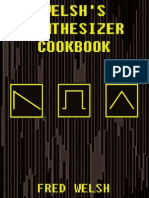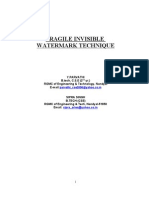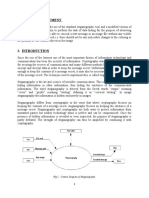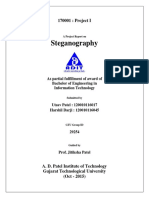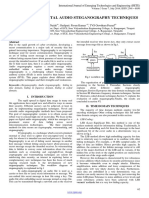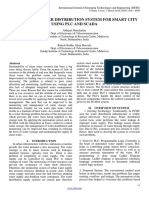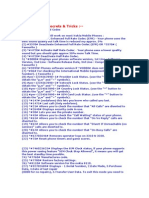Digital Watermarking Using Least Significant Bit Algorithm
Uploaded by
ijeteeditorDigital Watermarking Using Least Significant Bit Algorithm
Uploaded by
ijeteeditorInternational Journal of Emerging Technologies and Engineering (IJETE)
Volume 2 Issue 3, March 2015, ISSN 2348 8050
Digital Watermarking Using Least Significant Bit Algorithm
Neha Jadhav, Suverna Kharat, Punam Nagare.
Guided By Prof. Harsha Sarode
Nutan Maharashtra Institue of Engineering and Technology, Pune.
ABSTRACT:
Digital watermarking is one of the types of
digital signal which hidden directly in digital
content. It helps to make the distribution of
digital
material
more
secure.
Digital
watermarking has the properties like strongness,
security, transparency, complexity, capacity, and
verification. A Digital Watermarking is a form
of steganography in which copy-move and other
source information is hidden inside a document,
image or sound file without the users
knowledge. Many companies involved in digital
watermarking activities with different types of
watermarks. It discusses different techniques for
images, text and other applications of digital
watermarking.
KEYWORDS: Digital watermarking, LSB
1. INTRODUCTION:
Steganography is a method of hiding digital
information.Steganography can be applied to
many types of data, like audio, video, and
images and can hide any kind of digital
information.For security steganography consists
of a significant challenge as it hides the act of
communication; LSB steganography, in which
the lowest bit plane of a bitmap image is used to
convey the secret data, has long been known to
steganographers. Because the eye cannot detect
the very small perturbations it introduces into an
image and because it is extremely simple to
implement,1 LSB methods are commonly used
among the many free steganography tools
available on the internet. There are two types of
LSB steganography: LSB replacement and LSB
matching.In the LSB matching first split the
RGB channel of an input image into LSB and
non LSB(MSB).Then calculate the parity of non
LSB. Then set digital data(0,1) for even parity or
odd parity.Then in last compare the LSB with
the calculated part of non-LSB.And detect the
hidden part of an image.LSB replacement is
very similar, except that the LSBs of the cover
pixels are simply overwritten by the secret bit
stream.
2. PREVIOUS SYSTEM:
In this section a literature survey of digital
Watermarkings technique used for images is
presented. It shows the previous work which had
been done on digital watermarks and their
results.
1] Ersin Elbasi et al enclosed the watermark
in the Discrete Wavelet Transform domain. For
watermark enclosing, the two level DWT
decomposition of an NxN gray scale image I is
computed.
2] Gil-Je Lee et al , represented a simple and
strong watermarking technique
by using
random mapping function.The proposed
algorithm is watermark enclosing which can be
very strong than the simple watermarking
algorithm.
3] Saeid Fazli et al ,searched the trade-off
between unobservable and strongness of LSB
watermarking. In this algorithm, instead of
lower bit planes significant bit-planes of the
watermark image are put in picture. So, they
analyse the effect of image compression on the
watermark, and estimate the strongness and
unobserveability by calculating the distortion
occures due to watermarking.
4] Gaurav Bhatnagar et al , represented a new
semiblind reference watermarking scheme based
on discrete wavelet transform (DWT) and
singular value decomposition (SVD) for
copyright protection and authenticity.
3. PROPOSED SYSTEM:
43
www.ijete.org
International Journal of Emerging Technologies and Engineering (IJETE)
Volume 2 Issue 3, March 2015, ISSN 2348 8050
We proposed a new digital algorithm depends on
LSB techniques. Most of authers has proposed
the third and forth LSB but our proposed
watermarking algorithm is using first LSB for
hiding the data for security purpose. So, no one
will know that there is some data is hidden in
the image. To hide information in a cover
images, least significant bit technique is used.In
LSB techniques,pixels are changed by bits of
hidden message inside the image.To hide the
message inside image least bits needed to be
changed from eight bytes of grids. Only few
bits needed in an image to modify or hide a
secret message. Because the quality of the
Watermarked image is very low, less than 4-bit
LSB. While changing the LSB of a pixel,it
results in small changes in the intensity of the
colors.So these changes cannot be visible for
naked human eye.Only professional tracker
solve which type of information hidden inside
the image. For example,Figure 1 shows the 1-bit
LSB. In Figure 1, the pixel value of the cover
image is(11000101)2 and the secret data is 0. It
is stored into LSB-1 therefore, the changed pixel
value of thepixel is (11000100)2. LSB can store
1-bit in each pixel. If the cover image size is 256
x 256 pixel image, it can thus store a total
amount of 65,536 bits or 8,192 bytes of hidden
data in an image
1
Pixel value
1
1
0
Secret data
0
1
0
0
Fig.2.Block Diagram Of LSB Watermarking.
3.2
WORKING
OF
LSB
WATERMARKING:
1.Take color image as a input.
2.separate RGB values of image.
3.Separate MSB and LSB of input image.
4.Calculate parities from MSB.
5.For even parity set 1 into LSB and for odd
parity set 0 into LSB.
6.Compare LSB.
7.If any change occurs then forgery detected.
3.3
FLOWCHART
WATERMARKING:
OF
LSB
Change pixel value
Fig.1.An example of 1 bit LSB
3.1
BLOCK DIAGRAM
WATERMARKING:
OF
LSB
44
www.ijete.org
International Journal of Emerging Technologies and Engineering (IJETE)
Volume 2 Issue 3, March 2015, ISSN 2348 8050
offers the promise of better protecting their
multimedia content from piracy.
It is
transparent in use, does not increase files sizes,
and yet is highly robust and secure. The
understanding of the theory behind digital
watermarking will lead to the design of more
reliable systems for more applications.LSB may
be detected simply through visual inspection of
an image and its bit-planes, or more reliably
through methods which use statistical metrics to
identify the likelihood an image contains hidden
data. Steganography proves to be a significant
technique for detection when communicating.
The detection issues with steganography create
challenges for security systems in attempting to
preventthe transmission of steganographic
content.
4. RESULTS:
Modified image
Modified image
Output image
Output image
REFERANCES:
Modified image
Output image
Modified image
Output image
Modified image
Output image
5. CONCLUSION:
For secure intelleactual property is currently a
very important topic for media, for university
administrators and for the publishing industries.
In digital watermarking robustness describes
whether the watermark can be reliably detected
after any changes in the original image like
rotation, scaling or cropping. It exists for
entertainment companies and libraries because it
1]S. Lyu and H. Farid, Steganalysis using color
wavelet statistics and oneclassvector support
machines,
in
Proc.
SPIE
Security,
Steganography,Watermarking
Multimedia
Contents, vol. 5306, E. J. Delp III and P.
W.Wong, Eds., 2004, pp. 3545.
2]J. Fridrich, Feature-based steganalysis for
JPEG images and its implicationsfor future
design of steganographic schemes, in Proc. Inf.
HidingWorkshop, Springer LNCS, vol. 3200,
2004, pp. 6781.
3] Gonzalez, Rafael C., and Paul A. Wintz.
"Image Compression Standards."Digital Image
Processing. 2nd ed. Upper Saddle River, NJ:
Prentice-Hall, 2002.492-510. Print.
4] Lyu, S., & Farid, H.(2006).Steganalysis using
higher-order image statistics.Forensics and
Security, IEEE Transactions on, 1(1), 111-119.
5]Kundur, Deepa. Watermarking with diversity:
Insightsand implications. IEEE Multimedia,
2001, 8(4), 46-52.
6] Page, Thomas. Rights management:
Digitalwatermarking as a form of copyright
protection. Computer Law & Sec. Rep., 1998,
14(6), 390-92.
7] Rao,N.V.& Pandit, S.N.N. Multimedia digital
rightsprotection using watermarking techniques.
Inform.Sys. Sec., 2007, September, 93-99.
8] Rosenblatt, Bill. DRM, law and technology:
AnAmerican perspective. Online Inform. Rev.,
2007
45
www.ijete.org
International Journal of Emerging Technologies and Engineering (IJETE)
Volume 2 Issue 3, March 2015, ISSN 2348 8050
46
www.ijete.org
You might also like
- TriPac EVOLUTION Diagnostic Manual 55739-19-OD Rev 0 (08-13)86% (21)TriPac EVOLUTION Diagnostic Manual 55739-19-OD Rev 0 (08-13)341 pages
- A Discovery of Witches Deborah E. Harkness84% (64)A Discovery of Witches Deborah E. Harkness283 pages
- The Hacker Playbook 1 - Practical Guide To Penetration Testing91% (11)The Hacker Playbook 1 - Practical Guide To Penetration Testing308 pages
- CompTIA Network+ Certification Passport, 7th Edition Exam N10 008100% (6)CompTIA Network+ Certification Passport, 7th Edition Exam N10 008449 pages
- Universal Codes For Cell Phones and Advanced Tricks80% (5)Universal Codes For Cell Phones and Advanced Tricks30 pages
- American Survival Guide, Prepper Survival Field Manual - Spring 2017100% (12)American Survival Guide, Prepper Survival Field Manual - Spring 2017132 pages
- Cannibalism Blood Drinking High Adept Satanism by Kerth Barker Z Liborgepub100% (5)Cannibalism Blood Drinking High Adept Satanism by Kerth Barker Z Liborgepub194 pages
- LSB Based Digital Watermarking TechniqueNo ratings yetLSB Based Digital Watermarking Technique4 pages
- An Overview of Image Steganography Techniques: WWW - Ijecs.inNo ratings yetAn Overview of Image Steganography Techniques: WWW - Ijecs.in5 pages
- Steganography in Images Using LSB Technique: Arun Kumar SinghNo ratings yetSteganography in Images Using LSB Technique: Arun Kumar Singh5 pages
- Toward Robust Logo Watermarking Using Multiresolution Image Fusion PrinciplesNo ratings yetToward Robust Logo Watermarking Using Multiresolution Image Fusion Principles14 pages
- Information Security Through Digital Image Steganography Using Multilevel and Compression TechniqueNo ratings yetInformation Security Through Digital Image Steganography Using Multilevel and Compression Technique9 pages
- A Novel Method of Reducing Additive Distortion in Steganography With Embedding OperationNo ratings yetA Novel Method of Reducing Additive Distortion in Steganography With Embedding Operation6 pages
- Optimal Specifications For A Secure Image Steganography MethodNo ratings yetOptimal Specifications For A Secure Image Steganography Method5 pages
- An Improved LSB Image Steganography Technique Using Bit-Inverse in 24 Bit Colour ImageNo ratings yetAn Improved LSB Image Steganography Technique Using Bit-Inverse in 24 Bit Colour Image8 pages
- 1.1 Image Processing: Algorithms Image Processing Digital Images Digital Signal Processing Analog Image ProcessingNo ratings yet1.1 Image Processing: Algorithms Image Processing Digital Images Digital Signal Processing Analog Image Processing52 pages
- Performance Analysis of LSB, DCT, and DWT For Digital Watermarking Application Using SteganographyNo ratings yetPerformance Analysis of LSB, DCT, and DWT For Digital Watermarking Application Using Steganography6 pages
- An Image Steganography Algorithm Using LSB Replacement Through XOR Substitution100% (1)An Image Steganography Algorithm Using LSB Replacement Through XOR Substitution6 pages
- Innovative Multi-Level Secure Steganographic Scheme Based On Pixel Value DifferenceNo ratings yetInnovative Multi-Level Secure Steganographic Scheme Based On Pixel Value Difference13 pages
- (IJCST-V5I2P7) :Mrs.M.A.Wakure, Mrs.S.A.WakureNo ratings yet(IJCST-V5I2P7) :Mrs.M.A.Wakure, Mrs.S.A.Wakure5 pages
- An Imperceptible Blind Image Watermarking Scheme For Image Authentication Using DNA Encoding and Multi-Resolution Wavelet DecompositionNo ratings yetAn Imperceptible Blind Image Watermarking Scheme For Image Authentication Using DNA Encoding and Multi-Resolution Wavelet Decomposition8 pages
- September 2015: Saravanan Chandran Koushikk BhattacharyyaNo ratings yetSeptember 2015: Saravanan Chandran Koushikk Bhattacharyya6 pages
- Robust Fusion of WBCT & NMF For Video Watermarking Using Dynamic Frame SelectionNo ratings yetRobust Fusion of WBCT & NMF For Video Watermarking Using Dynamic Frame Selection5 pages
- Fragile Invisible Watermark Technique: Y.Parvathi B.tech, C.S.E (2 Yr.) RGMC of Engineering & Technology, Nandyal E-MailNo ratings yetFragile Invisible Watermark Technique: Y.Parvathi B.tech, C.S.E (2 Yr.) RGMC of Engineering & Technology, Nandyal E-Mail10 pages
- A_Steganographic_Method_for_Digital_Images_Robust_No ratings yetA_Steganographic_Method_for_Digital_Images_Robust_9 pages
- Analysis of Modern Steganographic Techniques: Remya UnnikrishnanNo ratings yetAnalysis of Modern Steganographic Techniques: Remya Unnikrishnan4 pages
- Image Watermarking Using Least Significant Bit AlgorithmNo ratings yetImage Watermarking Using Least Significant Bit Algorithm6 pages
- Advanced Hiding Technique For Rotated Text Message in Digital ImagesNo ratings yetAdvanced Hiding Technique For Rotated Text Message in Digital Images5 pages
- Conversion of 2D Stegano Image S Into A 3D Stereo Image Using RansacNo ratings yetConversion of 2D Stegano Image S Into A 3D Stereo Image Using Ransac5 pages
- Digital Watermarking: First A. Author, Second B. Author, JR., and Third C. Author, Member, IEEENo ratings yetDigital Watermarking: First A. Author, Second B. Author, JR., and Third C. Author, Member, IEEE2 pages
- EE7150 Finalproject-Finalreport Savitha Bhallamudi PDFNo ratings yetEE7150 Finalproject-Finalreport Savitha Bhallamudi PDF17 pages
- Spatial Data Authentication Through Novel Extended Hashing Algorithm in SteganographyNo ratings yetSpatial Data Authentication Through Novel Extended Hashing Algorithm in Steganography9 pages
- Robust Image Watermarking Based on Generative AdveNo ratings yetRobust Image Watermarking Based on Generative Adve27 pages
- Cascade Algorithm of Image Watermarking Based On Multiple Wavelet ComponentsNo ratings yetCascade Algorithm of Image Watermarking Based On Multiple Wavelet Components6 pages
- An Analysis of LSB DCT Based SteganographyNo ratings yetAn Analysis of LSB DCT Based Steganography6 pages
- A Novel Spatial Domain Technique For Digital Image Watermarking Using Block EntropyNo ratings yetA Novel Spatial Domain Technique For Digital Image Watermarking Using Block Entropy4 pages
- (IJCT-V2I1P5) Author :sonali V.Satonkar, DR - Seema KawathekarNo ratings yet(IJCT-V2I1P5) Author :sonali V.Satonkar, DR - Seema Kawathekar6 pages
- Visual Quality of Stego-Image Using Haar Wavelet: Subrahmanyam - CH, P.Kiranmayi, Dr.V.Sailaja, K.JyothiNo ratings yetVisual Quality of Stego-Image Using Haar Wavelet: Subrahmanyam - CH, P.Kiranmayi, Dr.V.Sailaja, K.Jyothi3 pages
- Evaluation Model For IP Network Routing Decision Based On PCA-ANNNo ratings yetEvaluation Model For IP Network Routing Decision Based On PCA-ANN5 pages
- Steganography Algorithm With Dynamic Pattern Matching: Yogadhar Pandey and Jagdish PimpleNo ratings yetSteganography Algorithm With Dynamic Pattern Matching: Yogadhar Pandey and Jagdish Pimple4 pages
- Efficient Algorithm For Digital Image SteganographyNo ratings yetEfficient Algorithm For Digital Image Steganography6 pages
- Image Compression: Efficient Techniques for Visual Data OptimizationFrom EverandImage Compression: Efficient Techniques for Visual Data OptimizationNo ratings yet
- AN IMPROVED TECHNIQUE FOR MIX NOISE AND BLURRING REMOVAL IN DIGITAL IMAGESFrom EverandAN IMPROVED TECHNIQUE FOR MIX NOISE AND BLURRING REMOVAL IN DIGITAL IMAGESNo ratings yet
- Human Visual System Model: Understanding Perception and ProcessingFrom EverandHuman Visual System Model: Understanding Perception and ProcessingNo ratings yet
- Data Science – Neural Networks, Deep Learning, LLMs and Power BIFrom EverandData Science – Neural Networks, Deep Learning, LLMs and Power BINo ratings yet
- Near-Net-Shape Superplastic Forming of Intricate Shaped Magnesium Alloy ComponentsNo ratings yetNear-Net-Shape Superplastic Forming of Intricate Shaped Magnesium Alloy Components8 pages
- Electrical Vehicle Charging by Wireless Power Transfer Using High-Power Three Level DC-DC ConvertersNo ratings yetElectrical Vehicle Charging by Wireless Power Transfer Using High-Power Three Level DC-DC Converters5 pages
- Modeling and Simulation of Single Phase CycloconvertorNo ratings yetModeling and Simulation of Single Phase Cycloconvertor3 pages
- Overview of Digital Audio Steganography TechniquesNo ratings yetOverview of Digital Audio Steganography Techniques5 pages
- Current Mode Controller Design For Single Phase Grid Connected Inverter Using Proportional Resonant Control StrategyNo ratings yetCurrent Mode Controller Design For Single Phase Grid Connected Inverter Using Proportional Resonant Control Strategy6 pages
- Buckling Analysis of Rectangular Plate by Split-Deflection MethodNo ratings yetBuckling Analysis of Rectangular Plate by Split-Deflection Method4 pages
- Automated Water Distribution System For Smart City Using PLC and ScadaNo ratings yetAutomated Water Distribution System For Smart City Using PLC and Scada4 pages
- Implimantation of Statistical Process Control in Small Scale Industries-A ReviewNo ratings yetImplimantation of Statistical Process Control in Small Scale Industries-A Review4 pages
- An Efficient and Reliable Data Routing For In-Network Aggregation in Wireless Sensor NetworkNo ratings yetAn Efficient and Reliable Data Routing For In-Network Aggregation in Wireless Sensor Network4 pages
- Use of PET (POLY ETHYLENE TERAPHTALATE) WASTE in Bituminous Road Construction - A Critical ReviewNo ratings yetUse of PET (POLY ETHYLENE TERAPHTALATE) WASTE in Bituminous Road Construction - A Critical Review4 pages
- Experimental Study On Self Curing Concrete Using Sodium LignosulphonateNo ratings yetExperimental Study On Self Curing Concrete Using Sodium Lignosulphonate5 pages
- An Experimental Work On Concrete by Adding Bacillus SubtilisNo ratings yetAn Experimental Work On Concrete by Adding Bacillus Subtilis5 pages
- Ham Radio For The New Ham What To Do The Minute You Get Your Amateur Radio License - Stan Merrill50% (2)Ham Radio For The New Ham What To Do The Minute You Get Your Amateur Radio License - Stan Merrill137 pages
- GMC S15 Workshop Manual (S15-T15 Jimmy 4WD V6-4.3L VIN W (1996-1999) )No ratings yetGMC S15 Workshop Manual (S15-T15 Jimmy 4WD V6-4.3L VIN W (1996-1999) )18,212 pages
- Ham Radio An Easy Guide For Beginners - Steve Markelo100% (4)Ham Radio An Easy Guide For Beginners - Steve Markelo10 pages
- Domain Name System Explained Guide. DNS Guide100% (1)Domain Name System Explained Guide. DNS Guide26 pages
- Technical Reference Manual: Product Description - Vectra VL400No ratings yetTechnical Reference Manual: Product Description - Vectra VL40064 pages
- Shrimp Rover Robot Using Rocker Bogie MechanicsNo ratings yetShrimp Rover Robot Using Rocker Bogie Mechanics93 pages
- C# - Syntax Question - @HTML - LabelFor (M - m.UserName) - Stack Overflow PDFNo ratings yetC# - Syntax Question - @HTML - LabelFor (M - m.UserName) - Stack Overflow PDF3 pages
- Graphical Solutions of Linear Inequalities: 2 (2 X Y) 2 (X+ Y) 4No ratings yetGraphical Solutions of Linear Inequalities: 2 (2 X Y) 2 (X+ Y) 49 pages
- Configuration Guide: Smartconnector For Raw Syslog DaemonNo ratings yetConfiguration Guide: Smartconnector For Raw Syslog Daemon8 pages
- The Legacy of The Apple Lisa Personal Computer: An Outsider's ViewNo ratings yetThe Legacy of The Apple Lisa Personal Computer: An Outsider's View26 pages
- Sample Problems and Solution of Gauss Seidel and JacobiNo ratings yetSample Problems and Solution of Gauss Seidel and Jacobi10 pages
- TriPac EVOLUTION Diagnostic Manual 55739-19-OD Rev 0 (08-13)TriPac EVOLUTION Diagnostic Manual 55739-19-OD Rev 0 (08-13)
- The Hacker Playbook 1 - Practical Guide To Penetration TestingThe Hacker Playbook 1 - Practical Guide To Penetration Testing
- CompTIA Network+ Certification Passport, 7th Edition Exam N10 008CompTIA Network+ Certification Passport, 7th Edition Exam N10 008
- Universal Codes For Cell Phones and Advanced TricksUniversal Codes For Cell Phones and Advanced Tricks
- American Survival Guide, Prepper Survival Field Manual - Spring 2017American Survival Guide, Prepper Survival Field Manual - Spring 2017
- Cannibalism Blood Drinking High Adept Satanism by Kerth Barker Z LiborgepubCannibalism Blood Drinking High Adept Satanism by Kerth Barker Z Liborgepub
- An Overview of Image Steganography Techniques: WWW - Ijecs.inAn Overview of Image Steganography Techniques: WWW - Ijecs.in
- Steganography in Images Using LSB Technique: Arun Kumar SinghSteganography in Images Using LSB Technique: Arun Kumar Singh
- Toward Robust Logo Watermarking Using Multiresolution Image Fusion PrinciplesToward Robust Logo Watermarking Using Multiresolution Image Fusion Principles
- Information Security Through Digital Image Steganography Using Multilevel and Compression TechniqueInformation Security Through Digital Image Steganography Using Multilevel and Compression Technique
- A Novel Method of Reducing Additive Distortion in Steganography With Embedding OperationA Novel Method of Reducing Additive Distortion in Steganography With Embedding Operation
- Optimal Specifications For A Secure Image Steganography MethodOptimal Specifications For A Secure Image Steganography Method
- An Improved LSB Image Steganography Technique Using Bit-Inverse in 24 Bit Colour ImageAn Improved LSB Image Steganography Technique Using Bit-Inverse in 24 Bit Colour Image
- 1.1 Image Processing: Algorithms Image Processing Digital Images Digital Signal Processing Analog Image Processing1.1 Image Processing: Algorithms Image Processing Digital Images Digital Signal Processing Analog Image Processing
- Performance Analysis of LSB, DCT, and DWT For Digital Watermarking Application Using SteganographyPerformance Analysis of LSB, DCT, and DWT For Digital Watermarking Application Using Steganography
- An Image Steganography Algorithm Using LSB Replacement Through XOR SubstitutionAn Image Steganography Algorithm Using LSB Replacement Through XOR Substitution
- Innovative Multi-Level Secure Steganographic Scheme Based On Pixel Value DifferenceInnovative Multi-Level Secure Steganographic Scheme Based On Pixel Value Difference
- An Imperceptible Blind Image Watermarking Scheme For Image Authentication Using DNA Encoding and Multi-Resolution Wavelet DecompositionAn Imperceptible Blind Image Watermarking Scheme For Image Authentication Using DNA Encoding and Multi-Resolution Wavelet Decomposition
- September 2015: Saravanan Chandran Koushikk BhattacharyyaSeptember 2015: Saravanan Chandran Koushikk Bhattacharyya
- Robust Fusion of WBCT & NMF For Video Watermarking Using Dynamic Frame SelectionRobust Fusion of WBCT & NMF For Video Watermarking Using Dynamic Frame Selection
- Fragile Invisible Watermark Technique: Y.Parvathi B.tech, C.S.E (2 Yr.) RGMC of Engineering & Technology, Nandyal E-MailFragile Invisible Watermark Technique: Y.Parvathi B.tech, C.S.E (2 Yr.) RGMC of Engineering & Technology, Nandyal E-Mail
- A_Steganographic_Method_for_Digital_Images_Robust_A_Steganographic_Method_for_Digital_Images_Robust_
- Analysis of Modern Steganographic Techniques: Remya UnnikrishnanAnalysis of Modern Steganographic Techniques: Remya Unnikrishnan
- Image Watermarking Using Least Significant Bit AlgorithmImage Watermarking Using Least Significant Bit Algorithm
- Advanced Hiding Technique For Rotated Text Message in Digital ImagesAdvanced Hiding Technique For Rotated Text Message in Digital Images
- Conversion of 2D Stegano Image S Into A 3D Stereo Image Using RansacConversion of 2D Stegano Image S Into A 3D Stereo Image Using Ransac
- Digital Watermarking: First A. Author, Second B. Author, JR., and Third C. Author, Member, IEEEDigital Watermarking: First A. Author, Second B. Author, JR., and Third C. Author, Member, IEEE
- EE7150 Finalproject-Finalreport Savitha Bhallamudi PDFEE7150 Finalproject-Finalreport Savitha Bhallamudi PDF
- Spatial Data Authentication Through Novel Extended Hashing Algorithm in SteganographySpatial Data Authentication Through Novel Extended Hashing Algorithm in Steganography
- Robust Image Watermarking Based on Generative AdveRobust Image Watermarking Based on Generative Adve
- Cascade Algorithm of Image Watermarking Based On Multiple Wavelet ComponentsCascade Algorithm of Image Watermarking Based On Multiple Wavelet Components
- A Novel Spatial Domain Technique For Digital Image Watermarking Using Block EntropyA Novel Spatial Domain Technique For Digital Image Watermarking Using Block Entropy
- (IJCT-V2I1P5) Author :sonali V.Satonkar, DR - Seema Kawathekar(IJCT-V2I1P5) Author :sonali V.Satonkar, DR - Seema Kawathekar
- Visual Quality of Stego-Image Using Haar Wavelet: Subrahmanyam - CH, P.Kiranmayi, Dr.V.Sailaja, K.JyothiVisual Quality of Stego-Image Using Haar Wavelet: Subrahmanyam - CH, P.Kiranmayi, Dr.V.Sailaja, K.Jyothi
- Evaluation Model For IP Network Routing Decision Based On PCA-ANNEvaluation Model For IP Network Routing Decision Based On PCA-ANN
- Steganography Algorithm With Dynamic Pattern Matching: Yogadhar Pandey and Jagdish PimpleSteganography Algorithm With Dynamic Pattern Matching: Yogadhar Pandey and Jagdish Pimple
- Efficient Algorithm For Digital Image SteganographyEfficient Algorithm For Digital Image Steganography
- Image Compression: Efficient Techniques for Visual Data OptimizationFrom EverandImage Compression: Efficient Techniques for Visual Data Optimization
- AN IMPROVED TECHNIQUE FOR MIX NOISE AND BLURRING REMOVAL IN DIGITAL IMAGESFrom EverandAN IMPROVED TECHNIQUE FOR MIX NOISE AND BLURRING REMOVAL IN DIGITAL IMAGES
- Human Visual System Model: Understanding Perception and ProcessingFrom EverandHuman Visual System Model: Understanding Perception and Processing
- Data Science – Neural Networks, Deep Learning, LLMs and Power BIFrom EverandData Science – Neural Networks, Deep Learning, LLMs and Power BI
- Artificial Intelligence 2024 Book 2 of 2: AI, #2From EverandArtificial Intelligence 2024 Book 2 of 2: AI, #2
- Near-Net-Shape Superplastic Forming of Intricate Shaped Magnesium Alloy ComponentsNear-Net-Shape Superplastic Forming of Intricate Shaped Magnesium Alloy Components
- Electrical Vehicle Charging by Wireless Power Transfer Using High-Power Three Level DC-DC ConvertersElectrical Vehicle Charging by Wireless Power Transfer Using High-Power Three Level DC-DC Converters
- Modeling and Simulation of Single Phase CycloconvertorModeling and Simulation of Single Phase Cycloconvertor
- Overview of Digital Audio Steganography TechniquesOverview of Digital Audio Steganography Techniques
- Current Mode Controller Design For Single Phase Grid Connected Inverter Using Proportional Resonant Control StrategyCurrent Mode Controller Design For Single Phase Grid Connected Inverter Using Proportional Resonant Control Strategy
- Buckling Analysis of Rectangular Plate by Split-Deflection MethodBuckling Analysis of Rectangular Plate by Split-Deflection Method
- Automated Water Distribution System For Smart City Using PLC and ScadaAutomated Water Distribution System For Smart City Using PLC and Scada
- Implimantation of Statistical Process Control in Small Scale Industries-A ReviewImplimantation of Statistical Process Control in Small Scale Industries-A Review
- An Efficient and Reliable Data Routing For In-Network Aggregation in Wireless Sensor NetworkAn Efficient and Reliable Data Routing For In-Network Aggregation in Wireless Sensor Network
- Use of PET (POLY ETHYLENE TERAPHTALATE) WASTE in Bituminous Road Construction - A Critical ReviewUse of PET (POLY ETHYLENE TERAPHTALATE) WASTE in Bituminous Road Construction - A Critical Review
- Experimental Study On Self Curing Concrete Using Sodium LignosulphonateExperimental Study On Self Curing Concrete Using Sodium Lignosulphonate
- An Experimental Work On Concrete by Adding Bacillus SubtilisAn Experimental Work On Concrete by Adding Bacillus Subtilis
- Ham Radio For The New Ham What To Do The Minute You Get Your Amateur Radio License - Stan MerrillHam Radio For The New Ham What To Do The Minute You Get Your Amateur Radio License - Stan Merrill
- GMC S15 Workshop Manual (S15-T15 Jimmy 4WD V6-4.3L VIN W (1996-1999) )GMC S15 Workshop Manual (S15-T15 Jimmy 4WD V6-4.3L VIN W (1996-1999) )
- Ham Radio An Easy Guide For Beginners - Steve MarkeloHam Radio An Easy Guide For Beginners - Steve Markelo
- Technical Reference Manual: Product Description - Vectra VL400Technical Reference Manual: Product Description - Vectra VL400
- C# - Syntax Question - @HTML - LabelFor (M - m.UserName) - Stack Overflow PDFC# - Syntax Question - @HTML - LabelFor (M - m.UserName) - Stack Overflow PDF
- Graphical Solutions of Linear Inequalities: 2 (2 X Y) 2 (X+ Y) 4Graphical Solutions of Linear Inequalities: 2 (2 X Y) 2 (X+ Y) 4
- Configuration Guide: Smartconnector For Raw Syslog DaemonConfiguration Guide: Smartconnector For Raw Syslog Daemon
- The Legacy of The Apple Lisa Personal Computer: An Outsider's ViewThe Legacy of The Apple Lisa Personal Computer: An Outsider's View
- Sample Problems and Solution of Gauss Seidel and JacobiSample Problems and Solution of Gauss Seidel and Jacobi







